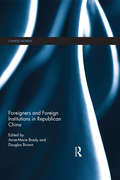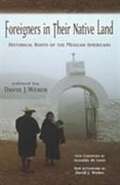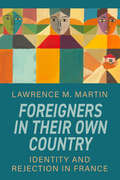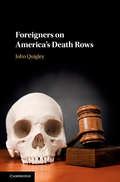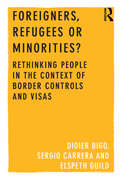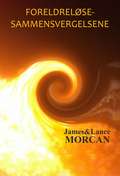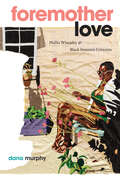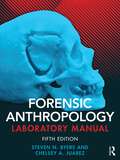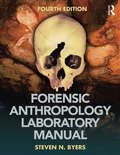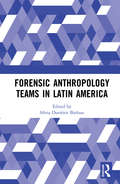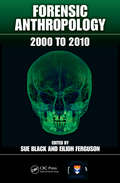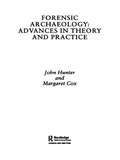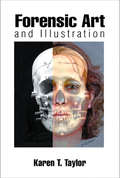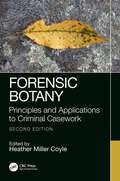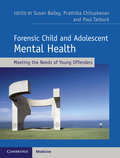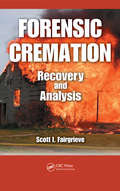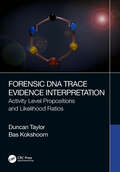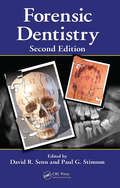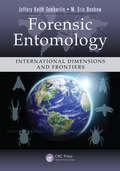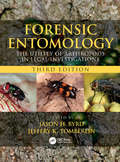- Table View
- List View
Foreigners and Foreign Institutions in Republican China (Chinese Worlds)
by Douglas Brown Anne-Marie BradyRepublican China attracted an uncommon diversity of foreign interests, groups, and individuals, which included missionaries, adventurers, diplomats, academics, humanitarians and refugees, as well as hedonists and tourists. By exploring the diverse nature of foreign activities in Republican China, this book complicates the dominant narratives of the imperialistic foreigner and Chinese victim, and moves beyond the depiction of foreigners as privileged and the Chinese as simply weak. The spaces and relationships examined in the essays in this volume reveal a complex series of interactions between foreigners and the people of China which go far beyond one-way transmission or exploitation. Indeed, this book examines how diverse and sometimes seemingly peripheral foreign individuals and communities influenced literature, education, trade, sexual morality, warfare, and architecture in China and in the process were themselves profoundly changed, in ways that are as remarkable as those experienced by the Chinese they had come to observe, meet, exploit, conquer, assist, or change. Bringing together the work of a diverse group of scholars on Republican China, this edited volume adopts a uniquely multi-disciplinary approach to the study of foreigners in China, and utilises the perspectives of historiography, literary studies, cultural studies, sociology, anthropology, and political science. As such, this interesting and innovative book will be of great interest to students and scholars from diverse fields including Chinese and global history, politics and international relations, Chinese studies, literary studies and gender studies.
Foreigners in Their Native Land: Historical Roots of the Mexican Americans
by David J. WeberWhen Weber's (history, Southern Methodist U., Dallas) anthology of 50 Spanish, Mexican and American writings was first published in 1973, it represented a bold effort to develop systematically the documentary sources for Mexican American history. With this 13th paperbound printing, the 30th anniversary edition proves the text's lasting value and appeal. The latest edition includes a new foreword by Arnoldo de Leon (history, Angelo State U., Texas) discussing the contribution Weber's text made, and continues to make, to the field of Mexican American history, and a new afterword by Weber, looking back at the creation of the book and assessing its continuing scholarly relevance today. Annotation ©2004 Book News, Inc., Portland, OR (booknews.com)
Foreigners in Their Own Country: Identity and Rejection in France
by Lawrence M. MartinBased on in-depth interviews with people throughout France who trace their origins to non-European countries, Foreigners in Their Own Country reports on the experience of not being seen as “French” because of one’s physical appearance. Paying close attention to how individuals speak about themselves and their feelings of acceptance or rejection, this book provides an intimate account of the challenges faced by the millions of people in France—and throughout Western Europe—who fully participate in the life of their country but are often not seen as belonging there.
Foreigners on America’s Death Rows: The Legal Combat Over Access To A Consul
by John QuigleyCapital cases involving foreigners as defendants are a serious source of contention between the United States and foreign governments. By treaty, foreigner defendants must be informed upon arrest that they may contact a consul of their home country for assistance, yet police and judges in the United States are lax in complying. <P><P>Foreigners on America's Death Row investigates the arbitrary way United States police departments, courts, and the Department of State implement well-established rights of foreigners arrested in the US. Foreign governments have taken the United States into international courts, which have ruled that the US must enforce the treaty. The United States has ignored these rulings. As a result, foreigners continue to be executed after a legal process that their home governments justifiably find to be flawed. When one country ignores the treaty rights of another as well as the decisions of international courts, the established order of international relations is threatened. Illustrates how the US government has given courts implausible arguments in order to allow state governments to execute foreigners in circumstances that violate the human rights of those foreigners and treaty obligations owed to foreign governments.<P> Helps readers to understand why foreign governments are angry when their nationals are executed in the United States.<P> Explains how the United States have become a pariah in the international community for failing to follow treaty rules that other countries follow.
Foreigners, Refugees or Minorities?: Rethinking People in the Context of Border Controls and Visas
by Didier BigoWhen immigration policy and the treatment of Roma collide in international relations there are surprising consequences which are revelatory of the underlying tensions between internal and external policies in the European Union. This book examines the relationship of citizenship, ethnicity and international relations and how these three aspects of the State, its people and its neighbours relate to one another. It studies the wide issue of international relations, citizenship and minority discrimination through the lens of the case study of European Roma who seek refugee status in Canada on account of their persecution in Europe. The volume assesses the relationships among citizenship, state protection and persecution and minority status, and how they can intersect with and destabilize foreign affairs. The central background to the book is the European treatment of Roma, their linkages with visa and asylum policies and their human rights repercussions . The various contributions reveal how modern liberal democracies can find themselves in contradictory positions concerning their citizens - when these are looking for protection abroad - and foreigners - in search of international protection - as a consequence of visa and pre-border surveillance policies and practices.
Foreldreløse-sammensvergelsene
by James Morcan Lance Morcan Elisabet NorrisDenne saksprosa boka handler om politiske, vitenskapelige og finansielle innsikt inn i Morcans' bestselgende internasjonale trillerserie Den Foreldreløsetrilogien (noveller som slår sammen fakta og fiksjon ved å innarbeide virkelige teorier om offentlige personer og store organisasjoner). Her gir forfatterne detaljert analyse for hver enkelt av disse kontroversielle teoriene. Foreldreløse-sammensvergelsene, med forord fra den ledende forskeren Dr. Takaaki Musha og etterord av den berømte historikeren Professor Richard Spence, innbefatter vanskelig-å-finne kunnskap. På mange måter er dette grundig undersøkte verket den hemmelige historien om 20. og 21. århundre. Men mer enn bare en historie, avslører den også hva som skjer akkurat nå bak kulissene - i undergrunnsbunkere, i maktens korridorer, i de største bankene og møtene hos verdens eliter. Morcanene kobler prikkene mellom mange illberyktede hendelser i nyere tid og fjerner de tilsynelatende uendelige klassifiserte lagene av regjeringer og etterretningsbyråer. Sjokkerende, avslører de en avbryter sivilasjon som arbeider i blant oss og har til rådighet ekstraordinære undertrykte teknologier, ubegrensa ressurser og enorme svarte budsjetter - alt uforvarende finansiert av hverdagens skattebetaler. Med sine innsamlede bevis fra rettsaker, deklassifiserte regjeringsfiler og hovedstrømmens medierapporter, formidler forfatterne lite kjente fakta om en lang rekke emner. Skrevet fra forskjellige perspektiver; enkelte ganger ved å gi en stemme til sammensvergelsesteoretikere; andre ganger ved å støtte tvilere; skiftende mellom seriøs undersøkende skriving og ironi, selvironisk humor - leverer Foreldreløse-sammensvergelsene en balansert avsløring av noen av de viktigste saker i vår tid. Gå lengre enn rykter og sammensvergelsesteorier til dokumenterte fakta og bekreftet virkelighet og finn ut hvor dypt kaninh
Foremother Love: Phillis Wheatley and Black Feminist Criticism (Black Feminism on the Edge)
by Dana MurphyIn Foremother Love, Dana Murphy examines the importance of eighteenth-century poet Phillis Wheatley as a foundational figure for Black feminist criticism. Murphy establishes Phillis (as she refers to her) as a writer who wrote in response to and in conversation with other creators as well as a critic who was invested in sharing, explaining, and evaluating her own and others’ work and contexts. Indeed, Phillis played a key role in the development of what Murphy calls “foremother love”—the Black feminist depiction of the love of an unrelated feminist ancestor as a legitimate relation for the practice of inheritance, mourning, liberation, and friendship. Drawing on the work of Barbara Christian, June Jordan, Audre Lorde, Barbara Smith, and others, Murphy shows that Black feminist criticism becomes a transhistorical theorization when read in conjunction with Phillis’s labor and vision. Revealing how Phillis lives on in Black feminist criticism, Murphy contends that foremother love is an ethic of critical care that implores readers to recognize the affective labor of all those working in the field.
Forensic Anthropology (Solving Crimes With Science: Forensics)
by Angela LibalWelcome to the exciting world of forensic investigation--the science of solving crimes. This introduces the field of forensic anthropology, where scientists and criminal investigators use the human skeleton to solve some of the world's most mysterious and violent crimes. From the nineteenth-century murderer who boiled his wife in a vat of acid, to the modern-day pig farmer accused of murdering more than sixty women, forensic anthropology shows how even the tiniest fragments of bones can reveal the identities of victims as well as killers. From mass-transit accidents to war to genocide and terrorist attacks, this science also pieces together the most scattered and seemingly unidentifiable remains. Using recent finds such as bags of bones in the woods, or the five-thousand-year-old skeleton of a victim of foul play, forensic detectives use the smallest clues, revealing a massive crime-recording device: the human body. See how the dead do tell tales to those who know how to listen!
Forensic Anthropology Laboratory Manual
by Steven N. Byers Chelsey A. JuarezThis manual provides students in academic laboratory courses with hands-on experience in the major processes of forensic anthropology. Designed to accompany the textbook Introduction to Forensic Anthropology, sixth edition, the manual introduces core procedures and protocol, with exercise worksheets to reinforce the methodologies of forensic anthropology and enhance student comprehension. For the fifth edition, the manual has been updated in line with the textbook, incorporating new methods, figures, and worksheets. Each chapter contains explanations of the terminology, osteological features, and measurements needed to understand each of the topics. New for this edition, in many chapters students will find the incorporation of QR codes to give them immediate access to relevant video or website content to assist with the task at hand. In addition, in an attempt to create an inclusive learning environment, the authors have included online resources for most chapters that can be used in place of skeletons or other classroom resources so that all students can utilize the lab manual regardless of their classroom setup. Chapters may be covered in one session or multiple sessions and include lists of both basic and optional lab materials, enabling instructors to tailor each lab to the resources they have available.
Forensic Anthropology Laboratory Manual
by Steven N. ByersThis manual provides students in academic laboratory courses with hands-on experience of the major processes of forensic anthropology. Designed to accompany the textbook Introduction to Forensic Anthropology, the manual introduces core procedures and protocol, with exercise worksheets to reinforce the methodologies of forensic anthropology and enhance student comprehension.?For the fourth edition, the manual has been updated in line with the textbook, incorporating new methods, figures, and worksheets. Each chapter contains explanations of the terminology, osteological features, and measurements needed to understand each of the topics.? Chapters may be covered in one session or multiple sessions and include lists of both basic and optional lab materials, enabling instructors to tailor each lab to the resources they have available.
Forensic Anthropology Teams in Latin America
by Silvia Dutrénit BielousThis book charts the development of forensic anthropology teams in Latin America and surveys their main characteristics, achievements, and challenges in light of a recent past fraught with state repression and violence. The volume contains contributions by an interdisciplinary group of scholars from several Latin American universities, with chapters on Argentina, Chile, Uruguay, Peru, Guatemala, and Mexico. These countries’ shared legacy is a host of human rights violations that continue to have an impact on present day society. Following the move towards democracy and a public demand for truth and justice, the volume highlights the role of forensic anthropology teams and their contribution as a source of information for the historical narrative, as a legal asset in enforcing the right to truth, and in achieving reparation for victims. This collection will be of interest to scholars from Anthropology, Latin American Studies, Politics, and History.
Forensic Anthropology Training Manual
by Karen Ramey BurnsProvides basic information on successfully collecting, processing, analyzing, and describing skeletal human remains. Forensic Anthropology Training Manual serves as a practical reference tool and a framework for training in forensic anthropology. The first chapter informs judges, attorneys, law enforcement personnel, and international workers of the information and services available from a professional forensic anthropologist. The first section (Chapters 2-11) is a training guide to assist in the study of human skeletal anatomy. The second section (Chapters 12-17) focuses on the specific work of the forensic anthropologist, beginning with an introduction to the forensic sciences. Learning Goals Upon completing this book readers will be able to: Have a strong foundation in human skeletal anatomy Explain how this knowledge contributes to the physical description and personal identification of human remains Understand the basics of excavating a grave, preparing a forensic report, and presenting expert witness testimony in a court of law Define forensic anthropology within the broader context of the forensic sciences Describe the work of today's forensic anthropologists
Forensic Anthropology: 2000 to 2010
by Sue Black Eilidh FergusonAdvances in our ability to analyse information from skeletal remains and subsequent developments in the field of forensic anthropology make it possible to identify more victims of homicides, mass-fatality disasters, and genocide. Summarizing the vast collection of international literature that has developed over the past decade, this volume explores critical themes fundamental to this evolving discipline. Topics discussed include age determination in juveniles and adults; sex, race, and ancestry determination; stature determination; dental and facial identification; skeletal trauma and bone pathology; taphonomy and comparative osteology; and identification from soft tissues.
Forensic Archaeology and New Multidisciplinary Approaches: Topics Discussed During the 2018-2023 European Meetings on Forensic Archaeology (EMFA) (Soil Forensics)
by Pier Matteo Barone Wj Mike GroenThis book presents the latest research and developments in forensic archaeology, as discussed at the European Meetings on Forensic Archaeology (EMFA) from 2018 to 2023. It captures the dynamic and multidisciplinary nature of the field, highlighting the challenges and innovations that have emerged over the last five years. Divided into three main parts, the book addresses critical aspects of forensic archaeology and its diverse applications. Part I on Forensic Archaeology from the Crime Scene explores cutting-edge methodologies and their application in various forensic contexts. Part II focuses on Forensic Anthropology and Humanitarian Investigations, presenting the study of human remains and the application of forensic archaeology in humanitarian contexts. The final part addresses Heritage Crimes and the role of forensic archaeology in investigating and preventing the illegal trade in artifacts and the destruction of cultural heritage sites. Contributions from both EMFA presenters and external experts provide a rich tapestry of theoretical advances and practical applications. This new volume is essential for forensic archaeologists, forensic scientists, law enforcement professionals, and scholars interested in the intersection of archaeology and forensic science. It serves as an important resource for those seeking to understand the complexities of forensic investigations.
Forensic Archaeology: Advances in Theory and Practice
by John Hunter Margaret CoxThis updated edition of a textbook universally hailed as an indispensable guide, is a complete introduction to the methods and means of forensic archaeology. Incorporating new advances in the field, new case studies, and charting the growth and development of the subject, Forensic Archaeology examines the four main fields of recovery, search, skeletal analysis and analytical science, and how the concepts and methods of traditional archaeology can by utilized within criminal investigations. The authors provide in-depth chapters that discuss: search and location the various constraints and issues posed by an increasingly complex legal environment the archaeology of individual and mass graves how the subject has evolved to include international investigations of human rights links with forensic anthropology forensic geophysical survey. This is an invaluable resource that will provide students, researchers, academics and the general reader alike with a fascinating introduction to this complex and crucial subject.
Forensic Art and Illustration
by Karen T. TaylorAs the number of stranger-on-stranger crimes increases, solving these crimes becomes more challenging. Forensic illustration has become increasingly important as a tool in identifying both perpetrators and victims. Now a leading forensic artist, who has taught this subject at law enforcement academies, schools, and universities internationally, off
Forensic Botany: Principles and Applications to Criminal Casework
by Heather Miller CoyleForensic Botany: Principles and Applications to Criminal Casework, Second Edition updates what, at the time, was the very first book published on the subject. This latest edition offers a concise introduction to plant identification, biology, genetics, and how to utilize and apply botanical evidence in criminal cases.In recent years, forensic botany and the use of various plant and plant‑derived evidence have been increasingly utilized in criminal investigations and court cases. Likewise, forensic palynology and other such terms have entered the vernacular as botanical sciences have widened the applications in which such evidence can help solve cases. This includes the use of current and emergent genetic markers and DNA technology, toxicology, diatoms, and pollen. The numerous advances since the last edition was published necessitated added coverage of the technology and testing capabilities that have achieved new levels as the field has developed.The chapters are written by some of the top experts in the field. Every chapter in the Second Edition is fully updated, with several new chapters focusing on Random Amplified Polymorphic DNA (RAPD), Restriction Fragment Length Polymorphism (RFLP), and Amplified Fragment Length Polymorphism (AFLP), plant‑derived toxins and forensic toxicology, identifying ancient plants used in burial practices for dating sites, digested plants as evidence, and more.Forensic Botany, Second Edition provides scientists working with DNA, trace evidence, and botanical evidence—as well as investigators and legal professionals—with a thorough understanding of the latest advances and current capabilities in utilizing such evidence in investigating and adjudicating criminal cases.
Forensic Child and Adolescent Mental Health: Meeting the Needs of Young Offenders
by Susan Bailey Prathiba Chitsabesan Paul TarbuckWritten for practitioners and policymakers, this book will help professionals across health, education, social care and juvenile justice services to understand the needs of young offenders and adolescents at risk of entering the criminal justice system. Developmental in approach, the textbook provides a comprehensive overview of forensic child and adolescent mental health, using cases to help clinicians link theoretical principles to practice and understand how mental health and neurodevelopmental impairment can relate to offending behaviour. With an emphasis on preventive initiatives, early intervention and the building of psycho-social resilience through the delivery of values based practice, this book highlights the need for comprehensive assessment for young people across multiple domains of their lives. This book is of interest to all clinicians working within mental health teams, practitioners working with children and adolescents, professionals involved with youth justice and medico-legal issues, and politicians responsible for establishing health and social policy.
Forensic Cremation Recovery and Analysis
by Scott I. FairgrieveThis book provides a synopsis of the challenges involved in the recovery and interpretation of cremains from the point of discovery to the end of the analysis. It considers the capacity and mechanism of fire to alter the chemical and physical properties of materials, particularly those of human tissues, and emphasizes a flexible approach to the collection of cremains. A significant portion of the book examines the effects of fire on bone and the ability to determine trauma. It also evaluates the practical use of dental tissue and DNA for identification and as an aid to the investigation.
Forensic Criminology
by Andy WilliamsThis text provides an examination of the aetiological development of forensic criminology in the UK. It links the subjects of scientific criminology, criminal investigations, crime scene investigation, forensic science and the legal system and it provides an introduction to the important processes that take place between the crime scene and the courtroom. These processes help identify, define and label the ‘criminal’ and are crucial for understanding any form of crime within society. The book includes sections on: • the epistemological and ontological philosophies of the natural sciences; • the birth of scientific criminology and its search for the criminal ‘body’; • the development of early forms of forensic science and crime scene investigation; • investigating crime; • information, material and evidence; • crime analysis and crime mapping; • scientific support and crime scene examination; and • forensic science and detection methods and forensics in the courtroom. The text combines coverage of historical research and contemporary criminal justice processes and provides an introduction to the most common forensic practices, procedures and uses that enable the identification and successful prosecution of criminals. Forensic Criminology is essential for students of criminology, criminal justice, criminal investigations and crime science. It is also useful to those criminal justice practitioners wishing to gain a more in-depth understanding of the links between criminology, criminal investigations and forensics techniques.
Forensic DNA Trace Evidence Interpretation: Activity Level Propositions and Likelihood Ratios
by Duncan Taylor Bas KokshoornForensic DNA Trace Evidence Interpretation: Activity Level Propositions and Likelihood Ratios provides all foundational information required for a reader to understand the practice of evaluating forensic biology evidence given activity level propositions and to implement the practice into active casework within a forensic institution. The book begins by explaining basic concepts and foundational theory, pulling together research and studies that have accumulated in forensic journal literature over the last 20 years. The book explains the laws of probability - showing how they can be used to derive, from first principles, the likelihood ratio - used throughout the book to express the strength of evidence for any evaluation. Concepts such as the hierarchy of propositions, the difference between experts working in an investigative or evaluative mode and the practice of case assessment and interpretation are explained to provide the reader with a broad grounding in the topics that are important to understanding evaluation of evidence. Activity level evaluations are discussed in relation to biological material transferred from one object to another, the ability for biological material to persist on an item for a period of time or through an event, the ability to recover the biological material from the object when sampled for forensic testing and the expectations of the prevalence of biological material on objects in our environment. These concepts of transfer, persistence, prevalence and recovery are discussed in detail in addition to the factors that affect each of them. The authors go on to explain the evaluation process: how to structure case information and formulate propositions. This includes how a likelihood ratio formula can be derived to evaluate the forensic findings, introducing Bayesian networks and explaining what they represent and how they can be used in evaluations and showing how evaluation can be tested for robustness. Using these tools, the authors also demonstrate the ways that the methods used in activity level evaluations are applied to questions about body fluids. There are also chapters dedicated to reporting of results and implementation of activity level evaluation in a working forensic laboratory. Throughout the book, four cases are used as examples to demonstrate how to relate the theory to practice and detail how laboratories can integrate and implement activity level evaluation into their active casework.
Forensic Dentistry
by David R. Senn Paul G. StimsonThe identification of unknown individuals and the estimation of age, race, and gender are among the chief functions of forensic dentistry. Other important applications include the investigation and analysis of bitemarks and oral injuries in abuse cases and evaluating, reporting, and testifying in civil litigation cases. Twelve years after the benchmark first edition of this book explored these topics, the long-awaited Forensic Dentistry, Second Edition offers a comprehensive update and revision of the material.Offering insight from many new contributors on the cutting edge of forensic science and odontology, this new edition expands the book’s scope to include a broader historical and theoretical analysis, a thorough assessment of the past decade’s developments, and a far-reaching projection of future trends.New topics in the second edition include: Forensic dental radiography Age estimation Jurisprudence and legal issues History of forensic dentistry Landmark cases, including September 11th and Hurricane Katrina In order for forensic odontology to continue to progress as a specialty of forensic science, there must be a consistent stream of new ideas and original and applied research. Heavily illustrated and enhanced with a 16-page color insert with additional photos, this volume captures the critical issues that confront today’s forensic dentist, explores the field’s limitations, and provides a window on the future of this crucial sector within the forensic identification science arena.
Forensic Entomology: International Dimensions and Frontiers (Contemporary Topics in Entomology)
by M. Eric Benbow Jeffery Keith TomberlinThe use of forensic entomology has become established as a global science. Recent efforts in the field bridge multiple disciplines including, but not limited to, microbiology, chemistry, genetics, and systematics as well as ecology and evolution. The first book of its kind, Forensic Entomology: International Dimensions and Frontiers provides an inc
Forensic Entomology: The Utility of Arthropods in Legal Investigations, Third Edition
by Jason H. Byrd; Jeffery K. TomberlinForensic Entomology: The Utility of Arthropods in Legal Investigations, Third Edition continues in the tradition of the two best-selling prior editions and maintains its status as the single-most comprehensive book on Forensic Entomology currently available. It includes current, in-the-field best practices contributed by top professionals in the field who have advanced it through research and fieldwork over the last several decades. The use of entomology in crime scene and forensic investigations has never been more prevalent or useful given the work that can be done with entomological evidence. The book recounts briefly the many documented historical applications of forensic entomology over several thousand years. Chapters examine the biological foundations of insect biology and scientific underpinnings of forensic entomology, the principles that govern utilizing insects in legal and criminal investigations. The field today is diverse, both in topics studied, researched and practiced, as is the field of professionals that has expanded throughout the world to become a vital forensic sub-discipline. Forensic Entomology, Third Edition celebrates this diversity by including several new chapters by premier experts in the field that covers such emerging topics as wildlife forensic entomology, microbiomes, urban forensic entomology, and larval insect identification, many of which are covered in depth for the first time. The book will be an invaluable reference for investigators, legal professionals, researchers, practicing and aspiring forensic entomologists, and for the many students enrolled in forensic science and entomology university programs.
Forensic Facial Reconstruction
by Caroline WilkinsonThis book's major contributions include a detailed description of the Manchester method of facial reconstruction, using all the available published data on tissue depths and variation with age, sex, stature and ethnic origin. Caroline Wilkinson also includes an evaluation of the methods and problems associated with reconstructing the faces of children. Forensic facial reconstruction reproduces an individual's face from skeletal remains. Used when identification is otherwise impossible, it can give a name to the dead in forensic cases, or in archaeological contexts, provide a tangible impression of real individuals from our past.
